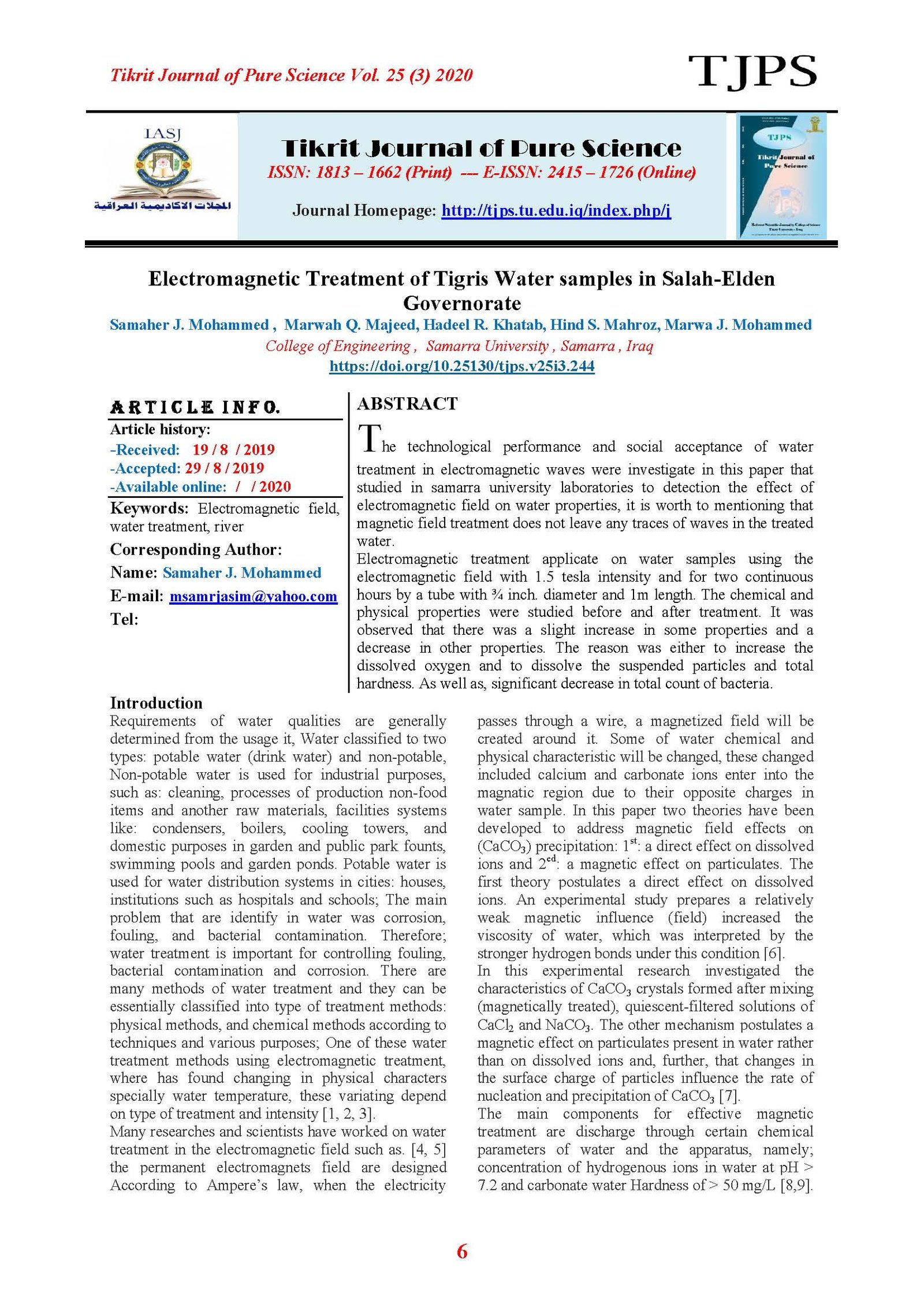Electromagnetic Treatment of Tigris Water samples in Salah-Elden Governorate
Main Article Content
Abstract
The technological performance and social acceptance of water treatment in electromagnetic waves were investigate in this paper that studied in samarra university laboratories to detection the effect of electromagnetic field on water properties, it is worth to mentioning that magnetic field treatment does not leave any traces of waves in the treated water.
Electromagnetic treatment applicate on water samples using the electromagnetic field with 1.5 tesla intensity and for two continuous hours by a tube with ¾ inch. diameter and 1m length. The chemical and physical properties were studied before and after treatment. It was observed that there was a slight increase in some properties and a decrease in other properties. The reason was either to increase the dissolved oxygen and to dissolve the suspended particles and total hardness. As well as, significant decrease in total count of bacteria
Article Details

This work is licensed under a Creative Commons Attribution 4.0 International License.
Tikrit Journal of Pure Science is licensed under the Creative Commons Attribution 4.0 International License, which allows users to copy, create extracts, abstracts, and new works from the article, alter and revise the article, and make commercial use of the article (including reuse and/or resale of the article by commercial entities), provided the user gives appropriate credit (with a link to the formal publication through the relevant DOI), provides a link to the license, indicates if changes were made, and the licensor is not represented as endorsing the use made of the work. The authors hold the copyright for their published work on the Tikrit J. Pure Sci. website, while Tikrit J. Pure Sci. is responsible for appreciate citation of their work, which is released under CC-BY-4.0, enabling the unrestricted use, distribution, and reproduction of an article in any medium, provided that the original work is properly cited.
References
[1] Ochkova, v.; and Chdova, j. (2013). Magnetic treatment of water: background and current state. 16th international conference on the properties of water and steam. UK.
[2] Koshoridze, S.I.; and Levin, Yu.K. (2011). Influence of colloidal particle coagulation on scale formation decrease in the process of magnetic water treatment at thermal engineering units. Thermal Engineering. No. (7). [3] Yahya, Sh.; and Abdul-Razaq, M. (2017). Effect of Irrigation Methods and Magnetization of Water on Quality of Sunflower and Water Use Efficiency. The Iraqi Journal of Agricultural sciences. 48 (4):920-929.
[4] Inaba, H.; Saitou, T.; Tozaki, K.; and Hayashi, H. (2004). Effect of the magnetic field on the melting transition of H2O and D2O measured by a high resolution and supersensitive differential scanning calorimeter. Applied Physics, 96 (11): 6127- 6132.
[5] Higashitani, K.; Kage, A.; Katamura, S.; Imai, K.; and Hatade, S. (1993). Effects of a magnetic field on the formation of CaCO3 particles. Colloid and Interface Science, 156 (1): 90-95.
[6] Ghauri, S.A.; and Ansari, M.S. (2006). Increase of water viscosity under the influence of magnetic field. Applied Physics, 100 (2).
[7] Barrett, R.A.; and Parsons, S.A. (1998). The influence of magnetic fields on calcium carbonate precipitation. Water Research, 32 (3): 609-612.
[8] Bogatin, J.; Bondarenko, N.; Gak, E.Z.; Rokhinson, E.E.; and Ananyev, I.P., (1999). Magnetic treatment of irrigation water: Experimental results and application conditions. Environmental Science and Technology, No. 33: 1280-1285.
[9] Mostafazadeh - Fard, B.; Khoshravesh, M.; Mousavi, S.F.; & Kiani A.R. (2011). Effects of Magnetized Water and Irrigation Water Salinity on Soil Moisture Distribution in Trickle Irrigation. ASCE, Journal of Irrigation and Drainage Engineering, American Society of Civil Engineering, 137 (6).
[10] Mohammed, S.; Majeed, M.; & Ahmed, A. (2019). Water treatment with silver plates and magnetic field: samarra case study. Journal of Advanced Research in Dynamical and control systems, 11(01): 1888-1895. [11] Alrudainy, A.; & Jumaa, A. (2016). Effect of Magnitized Water on Common Carp Cyprinus Carpio Rearing in Different Salinity Concetrations. Iraqi Journal of Agricultural Sciences, 47(2). [12] Ebrahim S.; and Azab A. (2017). Biological Effects of Magnetic Water on Human and Animals. Biomedical Sciences; 3(4): 78-85.
[13] Raafat, BM.; and Nabil GM. (2016). Hemoglobin different derivatives concentration enhancement after usage of magnetic treated water as drinking water. Inter J. Advan. Sci. Tech. Res., 6(1):415-424.
[14] Al-Jack, BH. (2001). The effect of magnetic water on milk properties and bacterial density. Scientific research DEMO, University of Science and Technology, Sudan.
